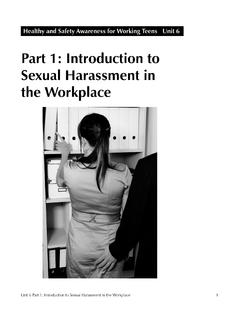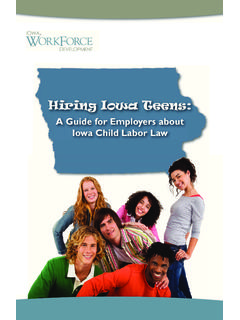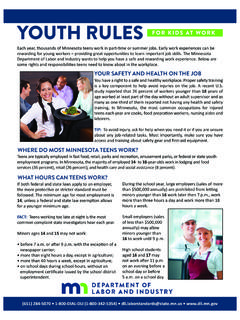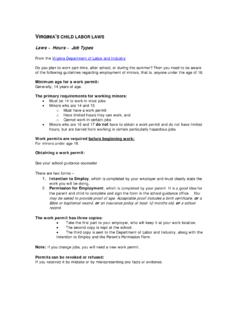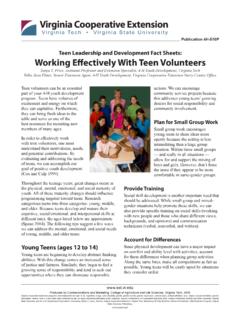Transcription of Lesson 1 Identifying Hazards - University of Washington ...
1 Identifying HazardsIdentifying Hazards Identifying HazardsIdentifying Hazards Identifying Hazards1-1 University of WashingtonHealth and Safety Awareness for working teens in AgricultureLesson 1 Identifying HazardsUpdated June 2006 Updated June 20061-2 Identifying HazardsUniversity of WashingtonHealth and Safety Awareness for working teens in AgricultureActivityTimeMaterialsPre-Test Individual5 minutesStudent Handout Master Lesson 1 Pre-TestActivity 1 AAwareness of Workplace Hazards : Warm-Up Discussion and DVDT eacher leads warm-up discussion of workplace Hazards . Students watch DVD Teen Workers: Real Jobs, Real Risks and discuss issues it raises. Class25 minutes DVD (Teen Workers: Real Jobs, Real Risks) and DVD player (Optional) Transparencies Master Workplace Injury Statistics Student Handout Master DVD Viewing Guide Master DVD Viewing Guide: Teacher Answer KeyActivity 1B Pre-Activity Discussion:Introduction to Job HazardsStudents list and categorize workplace health and safety minutes Overhead projector or boardActivity 1B Hazard Mapping Practice: Warehouse StoreStudents identify and label Hazards on an existing workplace and class10 minutes Colored pens or pencils Student Handout Master Sample Hazard Map:Warehouse Store Master Sample Hazard Map.
2 Teacher Answer KeyActivity 1B Mapping a Specifi c WorkplaceStudents create maps of workplaces and locate, label, and categorize work and safety Hazards on or small groups15 minutes Blank paper for making maps Colored pens or pencilsHomeworkComplete Hazard MapIndividual or small groups15-30 minutes Colored pens or pencilsPost-TestIndividual10 minutes Student Handout Master Lesson 1 Post-Test Master Lesson 1 Post-Test Teacher Answer KeyOptional HomeworkHealth and Safety InterviewsIndividual or small groups5-15 minutes Student Handout Master Workplace Health and Safety SurveyLesson 1 Identifying Hazards 1-3 Identifying HazardsUniversity of WashingtonHealth and Safety Awareness for working teens in AgricultureLesson 1 OverviewThe fi rst step in addressing health and safety issues in the work place is being able to identify problems and concerns. This Lesson introduces the concept of Hazards to the students through a short DVD and discussion (Activity 1B) this is followed by an exercise in hazard identifi cation and mapping to reinforce the concepts (Activity 1C).
3 Pre-TestStudents complete the Pre-Test to help them see what they do know/do not know about workplace Hazards . The Pre-Test can also be used to evaluate student learning at the end of the 1A Awareness of Workplace Hazards : Warm-up Discussion and DVDIn the discussion, students talk about the types of places they have worked and injuries that have occurred in their workplaces or those of friends or family. The DVD introduces the concept of workplace Hazards and gives suggestions for students on how to deal with Hazards . In a follow-up discussion students discuss ways to reduce 1B Hazard MappingThe hazard mapping activity highlights Hazards found in a variety of workplaces or classrooms (school greenhouse, metal shop, barn, etc.). Students identify and classify workplace Hazards in a class discussion and then practice mapping Hazards using a draw-ing of a warehouse store. Students then create their own maps of workplaces or classrooms and label and categorize the safety Hazards on the maps.
4 Post-TestStudents complete a Post-Test as a measure of what they have learned as a result of this Copies of Master Lesson 1 Post-Test Master Lesson 1 Post-Test Teacher Answer KeyLearning ObjectivesStudents will accomplish the following: Describe and analyze reasons why young workers get hurt on the job. Defi ne the term job hazard. 1-4 Identifying HazardsUniversity of WashingtonHealth and Safety Awareness for working teens in agriculture Provide examples of different types of job Hazards . Identify and locate Hazards in a workplace or classroom Identify four categories of health and safety Hazards in the workplace. Provide examples of each of the following categories of Hazards : physical, chemical, ergonomic and other State Essential Academic Learning Requirements (EALRs)This Lesson addresses the following EALRs:Health and skills to live safely and reduce health how environmental factors affect one s health and safety use images to support language to interact effectively and responsibly with cooperatively as a member of a agreement and solutions through discussionSocial Studies (Geography) and construct maps, charts and other resources1-5 Identifying HazardsUniversity of WashingtonHealth and Safety Awareness for working teens in AgricultureLesson 1 MastersTransparencies, Student Hand-outs, Teacher Answer Keys and Fact Injury Viewing Viewing Guide: Teacher Answer Key Hazard Map: Warehouse Hazard Map.
5 Teacher Answer Health and Safety 1 1 Post-Test Teacher Answer KeyPre-TestStudents will be given this pre-test to test their knowledge of workplace Hazards before this unit is taught. At the end of the unit, a post-unit survey will be given so that students and teachers can assess how much the students have learned as a result of this time: 5 minutesMaterials Student handouts: Master Lesson 1 Pre-Test student handouts of Master Lesson 1 Pre-Test prior to introducing any of the curriculum pre-test is used to fi nd out what students know about workplace health and safety before exposure to this curriculum. It is okay if they cannot answer all or most of the questions but they should try to answer the questions as best as possible. the pre-test right after its completion and keep it until the post-test is also completed. DO NOT LET THE STUDENTS KEEP THE PRE-TEST. (Answers to the test can be found in Lesson 1, Master Lesson 1 Post-Test Teacher Answer Key.)
6 Note: Please do not use the specifi c examples from the pre-test in your instruction during this unit, as this diminishes its value as an assessment HazardsUniversity of WashingtonHealth and Safety Awareness for working teens in AgricultureActivity 1 AAwareness of Workplace Hazards : Warm-up Discussion and DVDThe opening discussion personalizes the issue of workplace haz-ards by asking students to talk about injuries or illnesses they or their family members and friends have suffered at work. Teachers may also wish to introduce some statistics about injuries suffered by young workers in the and Washington state. Selected statistics can be found in Master Workplace Injury Statistics. The DVD shows job Hazards common to jobs where many teens work. It also describes ways teens can protect themselves, and things they can do if they see a safety problem. Activity time: 25 minutesMaterials TV/DVD player DVD Teen Workers: Real Jobs, Real Risks (Optional) Transparencies of Master Workplace Injury Statistics Student handout: Master DVD Viewing Guide Master DVD Viewing Guide: Teacher Answer KeyProcedureWarm-up Discussion (5 minutes) showing the DVD, ask the students, What kinds of jobs do you hold now or have you held in the past?
7 The class spend a few minutes talking about their answers. As students respond, make a list on the board of their work places. Your list might include: cattle ranch restaurant, fast food restaurant recreation facility1-7 Identifying HazardsUniversity of WashingtonHealth and Safety Awareness for working teens in agriculture plant nursery wheat farm offi ce retail ask the students, What kind of dangerous tasks or conditions do you think your job has/had? if anyone has ever been injured on their job or become ill because of their job. Discuss the injuries and illnesses briefl y. with follow-up questions regarding injuries and illnesses caused by the workplace. Possible questions include: What do you think caused the injury or illness? Could something have been done to prevent the illness or injury? Was something done to prevent the illness/injury? If yes, what? Do you know anyone else who has been injured at work? What were the injuries?
8 How did the person get hurt?DVD and Follow-up Discussion (15 minutes) Master DVD Viewing Guide. students to write answers to the questions on the guide while watching the DVD. (The questions on the guide are a summary of the issues posed in the DVD.) the DVD, Teen Workers: Real Jobs, Real Risks(13-minute DVD included with this curriculum). a brief class discussion based on the questions in the DVD viewing guide. Possible answers are listed in Master DVD Viewing Guide: Teacher Answer Key. Activity 1 BHazard MappingIn this activity students will identify and categorize a variety of job Hazards and learn how to map workplace Hazards . After practicing on an existing workplace map (Master Sample Hazard Map: Warehouse Store) students will create their own 1-8 Identifying HazardsUniversity of WashingtonHealth and Safety Awareness for working teens in Agriculturemaps, locating health and safety Hazards in a specifi c workplace or classroom (school greenhouse, metal shop, barn, etc.)
9 Students can work on these maps individually or in small groups, and will present their maps to the class at the end of this Lesson depending on the time available. (Optional) The assignment to map a specifi c workplace may also be used during job shadowing. With permission, have the students map the workplaces they visit. Activity time: 25-30 minutesMaterials Blank sheets of paper for making maps (standard x 11 paper for individual maps, larger sheets for group maps) Colored pens/pencils Overhead projector Student handouts of Master Sample Hazard Map: Warehouse Store Transparency of Master Sample Hazard Map: Warehouse Store Transparency of Master Sample Hazard Map: Teacher Answer KeyProcedurePre-Activity Discussion: Introduction to Job Hazards (10 minutes) students to try to defi ne the term job hazard. Write their responses on the board or overhead as they are suggested. See if everyone can agree on a defi nition.
10 Example of a summarized defi nition is: .A job hazard is anything at work that causes injury or illness, either physically or their defi nition, ask students to list as many workplace Hazards as they can. Write the list on the board or overhead. Questions to generate discussion may include: What Hazards have you noticed at your workplace?1-9 Identifying HazardsUniversity of WashingtonHealth and Safety Awareness for working teens in agriculture What Hazards have you heard about or seen at the workplaces of friends and family? What Hazards might you fi nd in a _____? (Name a workplace or school room, such as a shop, restaurant, offi ce, etc.) NOTE: Students may confuse the effects of Hazards with the Hazards themselves. For example, they may mention cuts rather than their cause, sharp objects. The potential cause is a hazard and should be listed on the board. If people mention effects rather than causes, explain the that the students will create a chart to categorize the Hazards .




